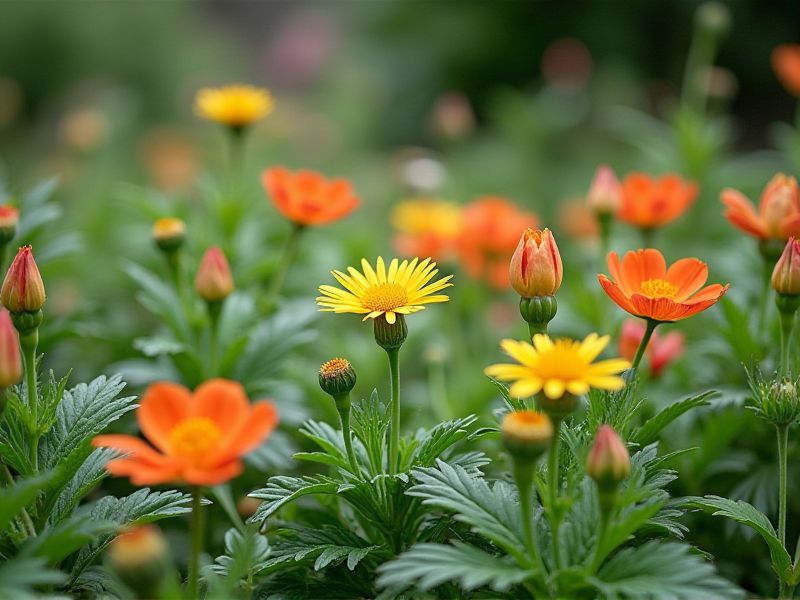
Border plants, such as boxwood, lavender, and ornamental grasses, play a crucial role in defining garden spaces and enhancing landscape aesthetics. These plants not only serve as natural dividers but also create visual interest and texture, making your outdoor areas more inviting. Low-growing varieties can outline pathways, while taller species can provide privacy or act as a backdrop for flower beds. Furthermore, incorporating seasonal blooms and foliage color can transform the dynamic of your garden throughout the year. Choosing the right border plants enhances both functionality and beauty, ultimately elevating your overall garden design.
List of some Border plants that define spaces
- Boxwood (Buxus sempervirens)
- Lavender (Lavandula)
- Yucca (Yucca filamentosa)
- Japanese Barberry (Berberis thunbergii)
- Ornamental Grasses (Miscanthus sinensis)
- Hydrangea (Hydrangea macrophylla)
- Holly (Ilex crenata)
- Privet (Ligustrum vulgare)
- Rosemary (Rosmarinus officinalis)
- Spirea (Spiraea japonica)
Important things about Border plants that define spaces
Aesthetic Appeal
Border plants serve as a visual delineation, enhancing the aesthetic appeal of gardens and landscapes. These plants, such as lavender, boxwood, and ornamental grasses, create a natural barrier that defines areas, guiding the eye and organizing the garden's design. By selecting border plants with complementary colors and textures, you can craft a harmonious flow that accentuates pathways, flower beds, or seating areas. Incorporating native species not only boosts local biodiversity but also ensures that your borders thrive with minimal maintenance, creating an inviting atmosphere.
Space Definition
Border plants serve as natural demarcations, defining spaces and creating visual boundaries within gardens and landscaping. These plants can vary from low-growing groundcovers like creeping thyme to taller shrubs such as boxwood or lavender, each providing structure and contrast. You can enhance your outdoor areas by strategically placing these plants to frame walkways, delineate flower beds, or create privacy screens. Border plants not only add aesthetic appeal but also help in maintaining the integrity of different sections in your landscape, fostering a cohesive design.
Privacy Enhancement
Border plants, such as boxwoods and hollies, effectively define outdoor spaces while providing a natural privacy screen. These evergreen shrubs not only create boundaries but also promote a feeling of seclusion in your garden or yard. When strategically placed, they can shield your area from prying eyes, enhancing the overall sense of security and intimacy. Utilizing hardy species suitable for your climate can ensure year-round coverage and minimal maintenance, allowing you to enjoy your private oasis uninterrupted.
Noise Reduction
Border plants effectively establish boundaries while providing essential noise reduction benefits in outdoor spaces. Dense foliage, such as evergreen shrubs or bamboo, absorbs sound waves, creating a tranquil environment, perfect for residential areas near busy roads. Additionally, strategically placed border plants enhance your landscape's aesthetic appeal, giving it a polished and sophisticated appearance. By choosing the right species, you can achieve both visual separation and enhanced acoustical privacy in your garden or yard.
Pathway Guidance
Border plants serve as natural dividers, effectively defining spaces in gardens and landscapes. Varieties such as lavender, boxwood, and ornamental grasses not only enhance visual interest but also create functional barriers that delineate areas within your outdoor environment. When strategically placed along pathways or property lines, these plants can offer both aesthetic appeal and privacy while providing habitats for local wildlife. Selecting the right border plants for your climate and design style ensures that your space is both inviting and well-organized.
Seasonal Interest
Border plants play a crucial role in defining outdoor spaces, creating visual boundaries while enhancing the beauty of gardens and landscapes. Varieties such as lavender, boxwood, and ornamental grasses not only delineate areas but also provide texture, color, and fragrance throughout the changing seasons. Incorporating a mix of perennial and annual border plants can ensure year-round interest, as some bloom in spring while others thrive in summer or fall. By thoughtfully selecting and arranging these plants, you can transform your outdoor space into a vibrant and inviting haven.
Plant Height Considerations
When selecting border plants to define spaces in your garden, consider using varying plant heights to create visual interest and depth. Taller species such as Delphiniums or Foxgloves can serve as striking backdrops, while mid-height perennials like Echinacea and Sedum complement them beautifully. Low-growing ground covers, such as Creeping Thyme or Ajuga, not only fill gaps but also provide texture at the forefront of your borders. By thoughtfully layering these plant heights, you can establish clear separations in your landscape while enhancing its overall aesthetic appeal.
Color Coordination
Border plants play a crucial role in defining outdoor spaces while enhancing color coordination in your garden. Selecting plants with complementary hues can create visual harmony, such as pairing vibrant red geraniums with lush green foliage or soft lavender with bold yellow daylilies. Incorporating various heights and textures further enriches the aesthetic appeal, making borders both functional and beautiful. Consider seasonal blooms to ensure your borders maintain interest throughout the year, showcasing a dynamic palette that evolves with changing seasons.
Texture Variation
Border plants, such as lavender and boxwood, offer a rich texture variation that can enhance the visual appeal of your garden. Using plants with different leaf shapes, sizes, and colors creates an engaging contrast, making your outdoor spaces feel more dynamic and inviting. For instance, the fine foliage of ornamental grasses juxtaposed with the broad leaves of hostas can define pathways and edges effectively. Incorporating these diverse textures not only accentuates boundaries but also contributes to the overall health and aesthetic of your garden design.
Low Maintenance Options
Border plants such as Lavender and Boxwood create clear boundaries while requiring minimal upkeep. These hardy options thrive in various climates, providing structure and beauty to your garden or landscape. By selecting plants like Ornamental Grasses or Sedum, you enhance visual interest while promoting ecological benefits, such as attracting pollinators. Whether you're defining a walkway or separating garden areas, these low maintenance choices ensure your space remains vibrant and organized with little effort.
